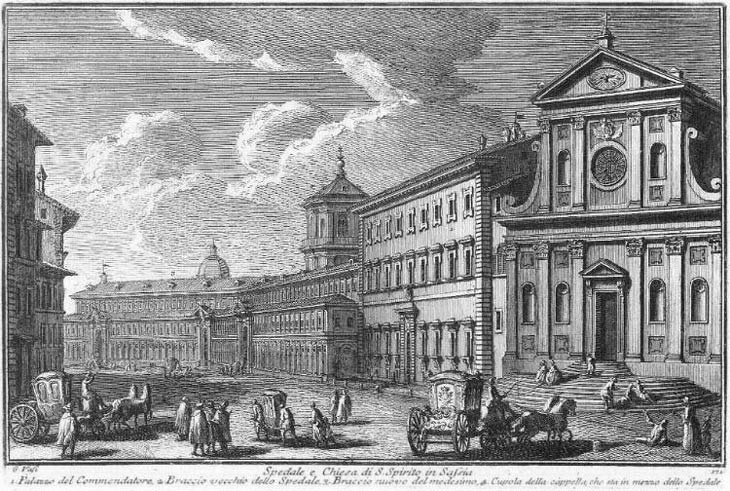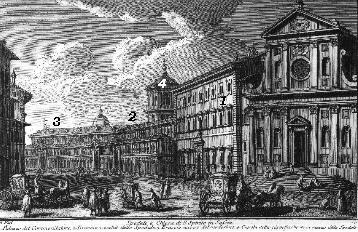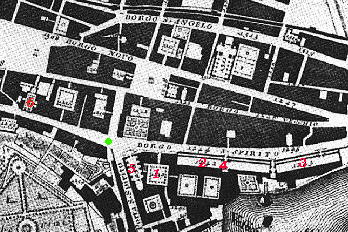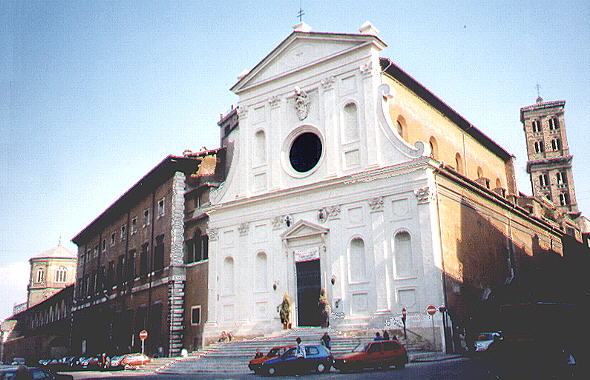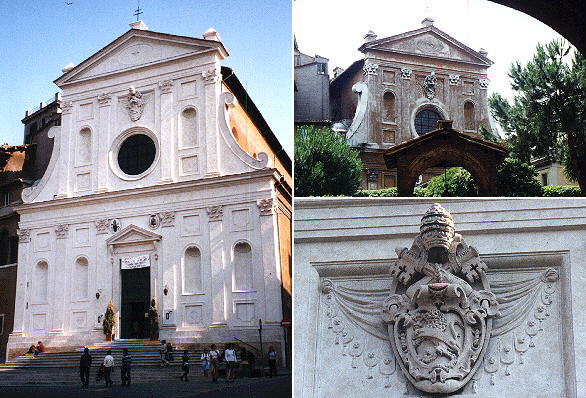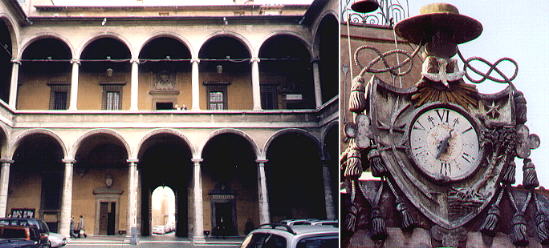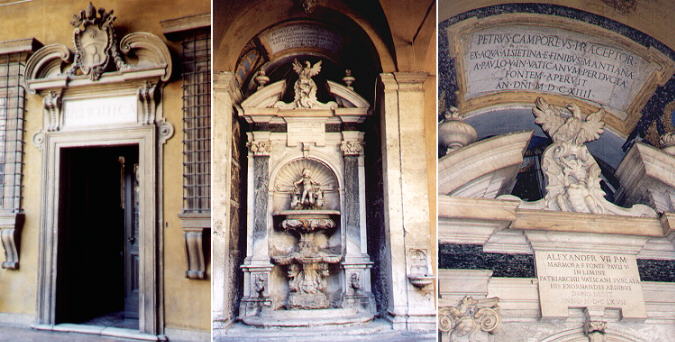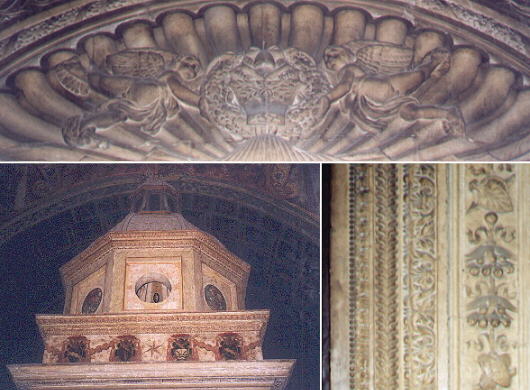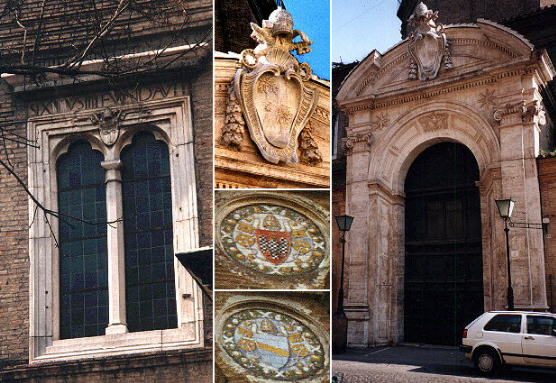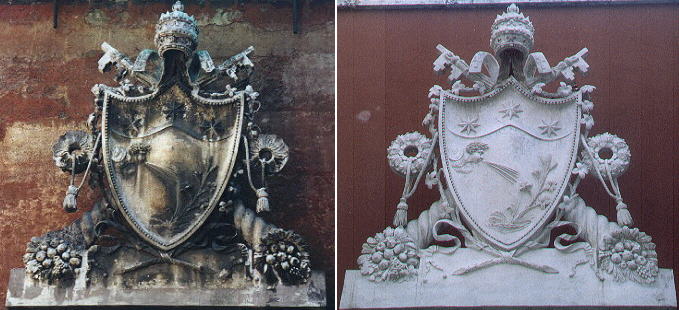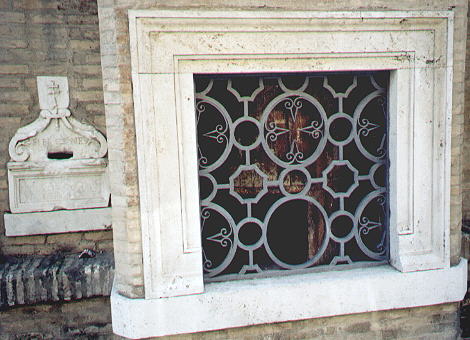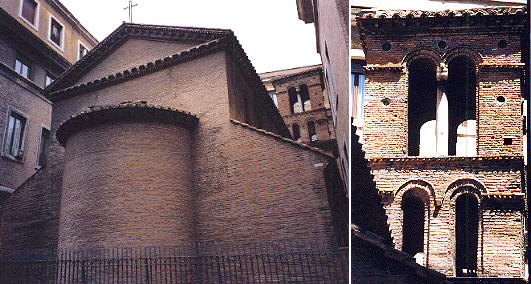

Spedale e Chiesa
di S. Spirito in Sassia (Book
9) (Map
D2) (Day 8) (View D3) (Rione Borgo)
In this page:
The plate by Giuseppe Vasi
Today's view
S. Spirito in Sassia
The hospital
Coats of arms
The Wheel
S. Lorenzo in Borgo
The Plate (No. 171)
Founded by Innocentius III the hospital was thoroughly rebuilt by
Baccio Pontelli under Sixtus IV, but many other Popes enlarged and enriched
it. In particular Benedictus XIV added Braccio Nuovo. The name comes
from the adjoining church founded by King Ina for the Saxon pilgrims (Sassia
= Sassonia = Saxony) in 728, which gave the name also to Porta
S. Spirito (click here for a list of national churches in Rome). The view is taken from the green dot in the 1748 map below.
In the description below the plate Vasi made reference to: 1) Palazzo del Commendatore; 2) Braccio vecchio (old part) dello Spedale; 3)
Braccio nuovo; 4) Dome of the Chapel.
The map shows also 5) Church of S. Spirito in Sassia; 6) S. Lorenzo in Borgo.
Today
The hospital is still in use with newly built facilities on the Lungotevere.
The quaying of the Tiber led to pulling down the Braccio Nuovo.
The Church
The church was rebuilt by Antonio da Sangallo, but the façade was
completed under Sixtus V, whose coat of arms is still there. The church
has just been repainted in white rather than in the reddish colour I was
accustomed to. Inside the church there are interesting tombs of the doctors who worked in the nearby hospital. You can see the fine ceiling of the church in a page covering
the ceilings of many Roman churches.
The Hospital
Next to the church, the courtyard of Palazzo del Commendatore (i.e.
the house of the director of the hospital) is rich in memories of popes
and cardinals. Paulus V celebrated with a fountain the ample supply of
water (Acqua Paola) he supplied to the hospital. A gigantic clock is placed in a cardinal's
coat of arms: the heraldic symbols are those of the hospital. The entrance to the library is topped by the coat of arms of Clemens XI.
The long ward built by Sixtus IV (Corsia Sistina) is split
by a large chapel with an octagonal dome. The portal with the coat of arms
of Sixtus IV is very finely decorated. The chapel contains an altar with
a baldaquin decorated with the heraldic symbols (stars and stripes) of Clemens VIII.
Coats
of Arms
In the hospital many coats of arms retain memories of the Popes who
left their mark on the vast building. Left: a window with the coat of arms
of Sixtus IV (neither original). Center: top: coat of arms of the entrance
built by Alexander VII; middle: coat of arms of Innocentius III (not original); bottom:
coat of arms of Eugenius IV (not original). Right: the entrance itself designed by Gian Lorenzo Bernini in 1664
(another entrance designed by Bernini is lost, but it can be seen in the engravings by Filippo Juvarra and Giovanni Battita Falda)..
Pius VI to celebrate an enlargement of the hospital put at the entrance
a colossal coat of arms (see below), which is now in a courtyard. You can see more about the initiatives of Pius VI in my page The Wind was too Strong.
The Wheel
The hospital relied on public donations and an alms-box is still visible outside Braccio Vecchio. It is located next to a wheel which was
used to accept abandoned babies. The grating has a larger hole to allow the passage of a baby. The
wheel was an effective way for managing with discretion the many cases of unwanted children.
S.
Lorenzo in Borgo
The church goes back to the XIIth century and in the XVth century
Cardinal Armellini incorporated it in his palace. In the 1930s it was
brought back to its original Romanic style. It is also called S. Lorenzo
in Piscibus, most likely after a nearby fish market.
Excerpts from Giuseppe Vasi 1761 Itinerary related to this page:
Spedale di s. Spirito in Sassia
Conserva questo Archiospedale l'antichissimo nome di quello, che quivi insieme con una chiesa dedicata alla ss. Vergine edificò Ina
Re de' Sassoni occidentali l'anno 717. per comodo de' pellegrini di sua nazione, e che chiamossi scuola de' Sassoni. Ma poi per un formidabile
incendio accaduto l'anno 817. ed altro nell'847. restando tutta questa contrada desolata, s. Leone IV. la riparò colli soccorsi de' Re di quelle
nazioni. Dipoi questa contrada essendo stata devastata da Arrigo IV. e da Federigo Barbarossa, il Pontefice Innocenzo III. nel 1198. ispirato
da Dio ordinò quivi la fabbrica di uno spedale per li poveri infermi, e per li projetti; e perchè si riconoscesse, che ciò fu per speciale ispirazione
divina, volle, che portasse il titolo di s. Spirito. Ne concedè la cura ad alcuni Preti regolari in quel medesimo tempo radunati in Francia per
servire gl'infermi, il fondatore de' quali chiamato Giulio Monpelieri fu da lui creato Commendatore di questo nuovo ordine di s. Spirito, che
dipoi si dilatò in benefizio de' poveri infermi, e projetti per tutta l'Italia, ed Europa. Perciò il medesimo Pontefice eresse appresso allo
spedale una chiesa dedicata allo Spirito santo, che poi nell'anno 1538 fu edificata di nuovo, ed ornata da vari Pontefici, e Cardinali, con
pitture, marmi, e stucchi dorati. Il disegno della chiesa è di Antonio da Sangallo, e quello del prospetto di Ottavio Mascherino; il ciborio
però è architettura di Andrea Palladio. Greg. XIII. vi fece col disegno del detto Mascherino il magnifico palazzo per il Commendatore, che
di ordinario è un Prelato, nel quale è una scelta libreria, aumentata da Monsig. Lancisi, e da molti Principi, fra' quali Lodovico XIV. Re di Francia.
Il Cav. Bernini rinnovò il braccio dello spedale con il portone, sotto Alessandro VII. ed il Cav. Fuga seguitò l'altro braccio col medesimo
disegno del Bernino, sotto il Pontificato di Benedetto XIV. L'altare isolato nello spedale vecchio è disegno del suddetto Andrea Palladio,
ed il quadro è di Carlo Maratti, il quale dipinse ancora la ss. Nunziata, che ora sta nel nuovo oratorio de' fratelli fatto
col disegno del Cav. Passalacqua. Le pitture a fresco nello spedale nuovo sono di Gregor. Giorgini, ed il quadro sull'altare è del Lanfranco.
Sonovi appresso le abitazioni distinte per i fanciulli, e per le fanciulle; queste apprendono i buoni costumi da alcune monache Agostiniane,
che ivi hanno il lor monastero, ed imparano i lavori proprj dalla loro età fino a tanto che si maritino, o si facciano religiose, e però vi è unita
una chiesa dedicata a s. Tecla. Li fanciulli sono istruiti nel leggere, e scrivere, e vengono trattenuti fino a tanto, che siano abili a procacciarsi il
vivere.
Chiesa di s. Lorenzo in Borgo
Si disse anticamente questa chiesa in piscibus, ed ora in borgo vecchio, perchè questa contrada è la più antica di tutte le altre, che
sono nella città Leonina. Nell'anno 1200. era questa chiesa unita alla basilica Vaticana, dipoi vi stettero alcune religiose di s. Chiara, le quali
essendo da Leone X. trasferite altrove, restò sotto la cura della Confraternita di s. Spirito. Quindi nel 1650. fu riedificata dalla nobilissima famiglia
Cesi, che quì accanto ha un magnifico palazzo ornato di statue, e marmi antichi; e fu conceduta la chiesa ai Chierici regolari delle scuole pie, i
quali ci hanno stabilito il loro noviziato. Conserva quella chie(sa) l'antica forma a tre navi, ornata con belle colonne, marmi, e pitture, fra le quali
evvi il s. Lorenzo dipinto da Giacinto Brandi, e lo sposalizio della santissima Vergine di Niccolò Berettori, le pitture però, che sono intorno alla
chiesa, e ne' laterali dell'altare maggiore sono di Michelangelo Ricciolini.
|
Next plate in Book 9: Spedale di S. Giovanni in Laterano
Next step in Day 8 itinerary: S. Maria in
Traspontina

Go
to  or to Book
9 or to the Plan
of my site or to my
or to Book
9 or to the Plan
of my site or to my
Home
Page on Baroque Rome or to my Home Page on Rome
in the footsteps of an XVIIIth century traveller.
|


